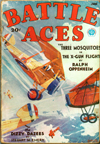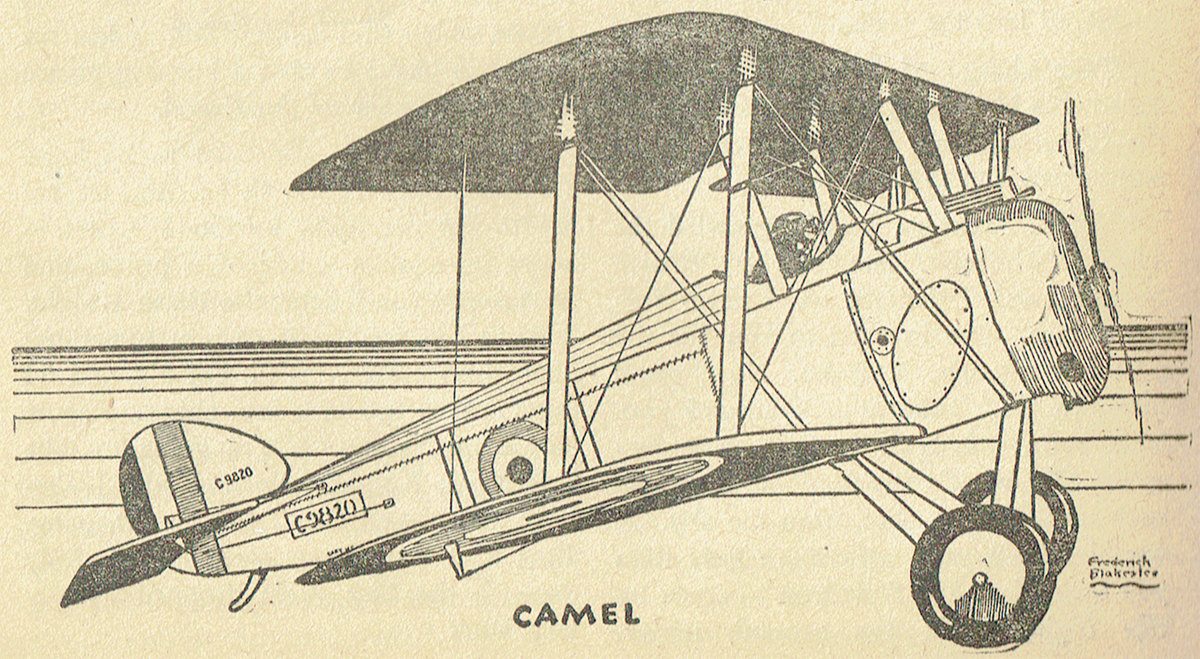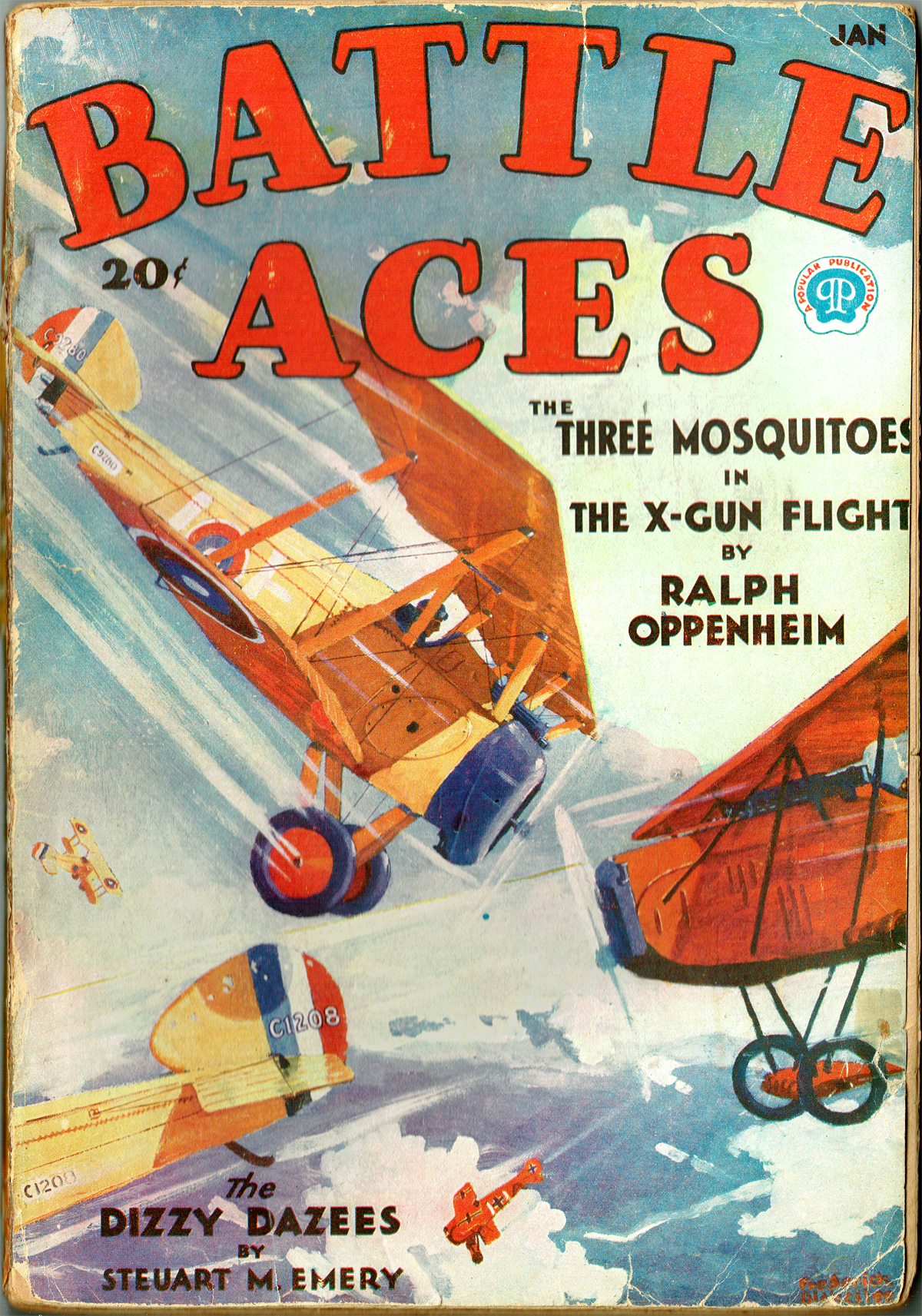“The Camel and Lt. White” by Frederick Blakeslee
Editor’s Note: This month’s cover is the eighth of the actual war-combat, pictures which Mr Blakeslee well-known artist and authority on aircraft, is painting exclusively for BATTLE ACES. The series was started to give our readers authentic pictures of war planes in color. It also enables you to follow famous airmen on many of their amazing adventures and feel the same thrill of battle they felt. Be sure to save these covers if you want your collection of this fine series to be complete.

Lt. Wilbert Wallace White, 147th Aero Squadron. He was a Flight Commander for the Squadron and gained 8 victories during his service.
 ON SEPTEMBER 14, 1918, three reconnaissance machines took the air on a mission of observation. They had for protection Second-lieutenant Wilbert W. White. While Lt. White was cruising about above the ships he was attacked by three Halberstadt fighters. He succeeded in fighting them off and leading them away from the observation ships, which were permitted to carry on their work unmolested. On his way home he sighted an enemy balloon near Chambley. He dove through a cloud to the attack, and before the ground crew knew what had happened, the drachen had come down about their ears in flames. The Yank was instantly attacked by two Fokker Scouts.
ON SEPTEMBER 14, 1918, three reconnaissance machines took the air on a mission of observation. They had for protection Second-lieutenant Wilbert W. White. While Lt. White was cruising about above the ships he was attacked by three Halberstadt fighters. He succeeded in fighting them off and leading them away from the observation ships, which were permitted to carry on their work unmolested. On his way home he sighted an enemy balloon near Chambley. He dove through a cloud to the attack, and before the ground crew knew what had happened, the drachen had come down about their ears in flames. The Yank was instantly attacked by two Fokker Scouts.
Although he was alone, with intrepid courage he attacked the first plane head-on, shooting until it went into a vertical dive out of control. Pulling sharply about, he fired a long burst at the second Fokker as it went over him. The Boche didn’t stop to argue, but streaked for the Vaterland as fast as his prop would drive him. For this thrilling exploit Lieutenant White was awarded the D.S.C.
The very next month he paid the supreme price in a way that was heroic in the extreme. He sacrificed his life that a buddy might live.
It was on October 10th that Lieutenant White, while in command of a patrol of four planes, met a flight of five Fokkers. In his patrol was a new member who was taking his first trip over the lines. One of the Boche pilots, perhaps sensing that he was a novice, or just by chances of combat, attacked him and obtained an advantageous position on his tail. The new pilot dodged and turned but was unable to shake off the Fokker, who followed his every move and was rapidly gaining on him. Lieutenant White saw that his friend was in dire trouble. Turning, he sped into position to attack the Boche. The Jerry was intent on his intended victim and was sending short bursts at close range whenever he could get him in line with his gun-sights. The situation looked black for the new pilot, but still blacker when Lieutenant White’s guns jammed hopelessly. Sooner or later a burst from the Fokker would hit a vital spot.
There was only one thing Lieutenant White could do to save his buddy, but it meant a horrible death. Without an instant’s hesitation he swung around and streaked full speed, head-on, into the startled and horrified enemy. The impact was terrific, the results devastating. For this act of extraordinary heroism the oak leaf cluster was awarded. The scene on the cover is just before the impact.
Lieutenant White belonged to the 147th squadron which used Spads. Since there was a picture of a 147th squadron Spad on last month’s cover, I have painted Lieutenant White’s machine as a Sophwith Camel to prevent repetition in plane types.

Much can be said for and against the Camel. It was an enlarged and modified “Pup” and was designed specially for high performances and extreme maneuverability. To obtain these ends some of the qualities of the Pup were necessarily sacrificed, and the machine had a reputation for being uncomfortable to fly. In fact I know of no pilot who went into a Camel squadron voluntarily.
Due to the torque of the motor it was extremely difficult to make a right-hand turn. This one fault caused a great many deaths to the men in training.
The Camel was also prone to catch fire in landing. The reason for this was because the engine, a 9-cylinder Gnome Monosoupape rotary, had no carbureter and therefore no throttle. It was necessary to slow down by means of a selector on the ignition system which cut out various cylinders. For example, the engine could run on 9-7-5-3 or one cylinder.
The mixture in the cylinders not used was sent through the exhaust manifold unburnt and might be ignited by the exhaust from an active cylinder. The ship landed with a long flame streaming from the exhaust which very often ignited the fabric.
On the other hand, it was the best ship for maneuvering ever brought out by the Allies, and was a great success in combat.
The Camel could climb to 5,000 feet in 5 minutes and to 10,000 feet in 12 minutes, at which height its speed was 113 m.p.h. It had a span of 28 feet; an overall length of 18 feet, 9 inches; a maximum gap of 5 feet and a minimum gap of 4 feet, F/io inches. A distinctive feature of this machine is the great dihedral of the bottom plane, combined with a flat top plane.
The ship received its name partly because of the appearance of a hump when seen from the side, and partly because the elevators were so sensitive that unless the pilot had a great deal of experience he flew in humps.

“The Camel and Lt. White” by Frederick M. Blakeslee (January 1931)





